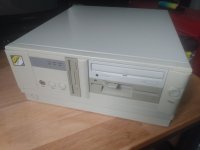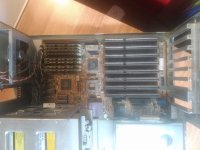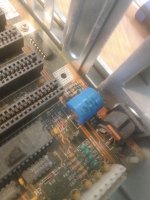mechaniputer
Experienced Member
- Joined
- May 23, 2015
- Messages
- 59
Hi,
I have a 386 desktop machine from around 1991 that currently works (as of last year). The machine was custom assembled by my dad around that time and was used as the family computer long enough to end up with Windows 95 and an ethernet NIC. I would like to make sure it keeps working for the long haul.
This machine had a long history of expansions and is a bit of a rats nest. It has the following parts:
My main concern is the caps and batteries. The motherboard seems to have one cylindrical 3.6v battery with a lead on either end, soldered on flat. There are also a TON of electrolytic caps on the sound card. I don't see any damage visually (but I haven't opened the PSU).
I try not to power it on very often because the PSU could fail and destroy the rest of it. I'm even a bit nervous to move the dust around too much, but a full disassembly and cleaning is probably in order, taking note of where everything is plugged in. Once I've gone over everything (after the advice I get here) I'll probably use it much more often.
And now, some questions:
I have a 386 desktop machine from around 1991 that currently works (as of last year). The machine was custom assembled by my dad around that time and was used as the family computer long enough to end up with Windows 95 and an ethernet NIC. I would like to make sure it keeps working for the long haul.
This machine had a long history of expansions and is a bit of a rats nest. It has the following parts:
- Am386DX/DXL-33 CPU
- Fortron FS200-40 PSU
- Motherboard with AMI BIOS (can't see a model number without disassembly)
- 8 MB RAM
- a hard drive
- 3.5" floppy drive
- 5.25" floppy that was retired but left in place (actually looks like it is still powered but no data cable)
- Yes, a turbo button
- Vortex VGA card
- 3COM Ethernet NIC with 1997 Copyright
- Some kind of serial mouse+floppy interface card (serial mouse port, plus the 3.5" floppy ribbon cable, and external serial/parallel ports) This card has a second external header connected,
- Creative CT2770 sound card
- A small card with ribbon+audio cables to the CD drive
My main concern is the caps and batteries. The motherboard seems to have one cylindrical 3.6v battery with a lead on either end, soldered on flat. There are also a TON of electrolytic caps on the sound card. I don't see any damage visually (but I haven't opened the PSU).
I try not to power it on very often because the PSU could fail and destroy the rest of it. I'm even a bit nervous to move the dust around too much, but a full disassembly and cleaning is probably in order, taking note of where everything is plugged in. Once I've gone over everything (after the advice I get here) I'll probably use it much more often.
And now, some questions:
- Does anyone have any suggestions or tips for when and how to replace the caps and battery?
- Is there a place I could mail the PSU (and/or sound card?) to get it completely recapped?
- Is there any other preventative maintenance I should be doing?
- I know the hard drive will have a finite lifespan. Any tips on the best solid-state replacements available?
Last edited:



